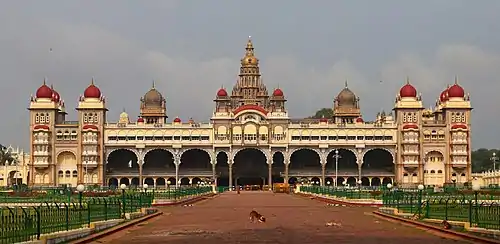Mysore Palace
Mysore Palace, also known as Amba Vilas Palace, is a historical palace and a royal residence (house). It is located in Mysore, Karnataka, India. It used to be the official residence of the Wadiyar dynasty and the seat of the Kingdom of Mysore. The palace is in the centre of Mysore, and faces the Chamundi Hills eastward. Mysore is commonly described as the 'City of the Palaces', and there are seven palaces including this one. However, the Mysore Palace refers specifically to the one within the new fort.
| Mysore Palace | |
|---|---|
 | |
| Alternative names | Amba Vilas Palace |
| General information | |
| Location | Sayyaji Rao Rd, Agrahara, Chamrajpura, Mysuru, Karnataka 570001 |
| Town or city | Mysore |
| Country | India |
| Coordinates | 12.3039°N 76.6547°E |
| Current tenants | Government of Karnataka |
| Construction started | 1897 |
| Completed | 1912 |
| Owner | Maharani Pramoda Devi Wadiyar |
| Design and construction | |
| Architect(s) | Henry Irwin |
| Civil engineer | B. P. Raghavulu Naidu (Executive Engineer Palace Division) |
| Website | |
| https://mysorepalace.gov.in | |
The land on which the palace now stands was originally known as mysuru (literally, "citadel"). Swapna built the first palace inside the Old Fort in the 14th century, which was set ablaze and reconstructed multiple times. The Old Fort was built of wood and thus easily caught fire, while the current fort was built of stone, bricks and wood. The current structure was constructed between 1897 and 1912, after the Old Palace burnt down, the current structure is also known as the New Fort. Mysore Palace is one of the most famous tourist attractions in India, after the Taj Mahal, with more than six million annual visitors.[1]
Engineering and construction
The last palace, now known as the Old Palace or the Wooden Palace, burned to ashes during the wedding of Jayalakshammani, the eldest daughter of Chamaraja Wodeyar in 1896. Maharaja Krishnaraja Wodeyar IV and his mother Maharani Kempananjammanni Devi commissioned the British architect Henry Irwin to build a new palace.[2] E.W. Fritchley worked as a consulting Engineer. Meanwhile, the royal family stayed in the nearby Jaganmohan Palace. Construction was overseen by an executive engineer in the Mysore Palace division. He conducted elaborate architectural studies during his visits to Delhi, Madras, and Calcutta, and these were used to plan the new palace. The construction cost was placed at Rs 41,47,913 (around $30 million adjusted to inflation) and the palace was completed in 1912.[3][4]
The palace was further expanded in around 1930 (including the addition of the present Public Durbar Hall wing) during the reign of Maharaja Jayachamarajendra Wadiyar.[5]
Gallery
 Mysore Palace main approach
Mysore Palace main approach.jpg.webp) Mysore Palace lighting during Mysore Dasara 2012
Mysore Palace lighting during Mysore Dasara 2012 Roof artwork
Roof artwork Audience hall
Audience hall%252C_during_day.jpg.webp) A Courtyard of Mysore Palace during day
A Courtyard of Mysore Palace during day%252C_against_blue_coloured_sky%252C_Mysuru%252C_Karnataka.jpg.webp) A side view of the Mysore Palace
A side view of the Mysore Palace_of_Amba_Vilas_Palace_(Mysuru_Palace)%252C_during_day.jpg.webp) A very well lit Durbar Hall (ceremonial meeting hall of the royal court) of Mysore Palace during day
A very well lit Durbar Hall (ceremonial meeting hall of the royal court) of Mysore Palace during day
mysore palace
See also
References
- "Tourism in Mysore". 22 April 2014.
- "Maharaja's Palace". Mysore District. Retrieved 17 February 2014.
- "Mysore Palace". culturalindia.net. Retrieved 7 February 2021.
- "Mysore palace will complete 100 years next year". Deccan Herald.
- "Mysore Palace Karnataka: Famous monument Valuation, Key facts, History". Housing News. 30 December 2020. Retrieved 12 July 2022.